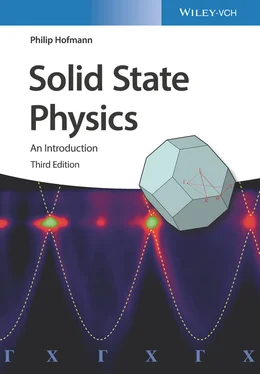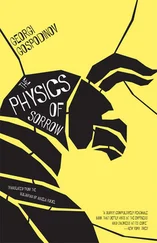Philip Hofmann - Solid State Physics
Здесь есть возможность читать онлайн «Philip Hofmann - Solid State Physics» — ознакомительный отрывок электронной книги совершенно бесплатно, а после прочтения отрывка купить полную версию. В некоторых случаях можно слушать аудио, скачать через торрент в формате fb2 и присутствует краткое содержание. Жанр: unrecognised, на английском языке. Описание произведения, (предисловие) а так же отзывы посетителей доступны на портале библиотеки ЛибКат.
- Название:Solid State Physics
- Автор:
- Жанр:
- Год:неизвестен
- ISBN:нет данных
- Рейтинг книги:4 / 5. Голосов: 1
-
Избранное:Добавить в избранное
- Отзывы:
-
Ваша оценка:
- 80
- 1
- 2
- 3
- 4
- 5
Solid State Physics: краткое содержание, описание и аннотация
Предлагаем к чтению аннотацию, описание, краткое содержание или предисловие (зависит от того, что написал сам автор книги «Solid State Physics»). Если вы не нашли необходимую информацию о книге — напишите в комментариях, мы постараемся отыскать её.
Solid State Physics
Solid State Physics
Solid State Physics
Solid State Physics — читать онлайн ознакомительный отрывок
Ниже представлен текст книги, разбитый по страницам. Система сохранения места последней прочитанной страницы, позволяет с удобством читать онлайн бесплатно книгу «Solid State Physics», без необходимости каждый раз заново искать на чём Вы остановились. Поставьте закладку, и сможете в любой момент перейти на страницу, на которой закончили чтение.
Интервал:
Закладка:
1.3.2 Other Methods for Structure Determination
While X‐ray diffraction is arguably the most widespread and most powerful method for structure determination, other techniques are used as well. Similar diffraction experiments can be carried out by making use of the wave character of neutrons or electrons. The former interact very weakly with matter because they carry no electric charge. They are also more difficult to produce than X‐rays. However, the use of neutrons has two distinct advantages over X‐rays: First, their interaction with light atoms is stronger than that of X‐rays, and second, they possess a magnetic moment, which means that they can interact with any magnetic moments in the solid, allowing one to determine its magnetic order. Electrons, on the other hand, have the advantages that they are easy to produce and that one can use electron‐optical imaging techniques, whereas making optical elements for X‐rays is very difficult. On the other hand, their very strong interaction with matter causes a breakdown of the kinematic approximation, that is, multiple scattering events have to be taken into account. Because of their strong interaction with matter, low‐energy electrons do not penetrate deeply into crystals. Therefore, they are more appropriate for surface structure determination.
1.3.3 Inelastic Scattering
Our discussion has been confined to the case of elastic scattering. In real experiments, however, the X‐rays or particles can also lose energy during the scattering events. This can be described formally by considering the diffraction from a structure that does not consist of atoms or ions at fixed positions but is time‐dependent, that is, which fluctuates with the frequencies of the atomic vibrations. We cannot go into the details of inelastic scattering processes here, but it is important to emphasize that inelastic scattering, in particular of neutrons, can be used to measure the vibrational properties of a lattice.
1.4 Further Reading
The concepts of lattice‐periodic solids, crystal structure, and X‐ray diffraction are discussed in all standard texts on solid state physics, for example:
Ashcroft, N.W. and Mermin, N.D. (1976). Solid State Physics. Holt‐Saunders.
Ibach, H. and Lüth, H. (2009). Solid State Physics, 4th edn. Springer.
Kittel, C. (2005). Introduction to Solid State Physics, 8th edn. John Wiley & Sons
Rosenberg, H.M. (1988). The Solid State. 3rd edn, Oxford University Press.
For a more detailed discussion of X‐ray diffraction, see, for example:
Als‐Nielsen, J. and McMorrow, D. (2011). Elements of Modern X‐Ray Physics, 2nd edn. John Wiley & Sons.
1.5 Discussion and Problems
Discussion
1 1.1 What mathematical concepts are used to describe the structure of any crystal?
2 1.2 What are the typical crystal structures of metals and why are they common?
3 1.3 Why do covalent crystals typically exhibit a much lower packing density than metallic crystals?
4 1.4 How can the reciprocal lattice conveniently be used to describe lattice‐periodic functions?
5 1.5 How can the structures of crystals be determined?
6 1.6 What is the difference between the Bragg and von Laue descriptions of X‐ray diffraction?
7 1.7 How can the reciprocal lattice of a crystal be used to predict the pattern of diffracted X‐rays?
Basic Concepts
1 1.1 Bravais lattice: Figure 1.13shows four two‐dimensional lattices.Which of the following statements is true?All four lattices are Bravais lattices.Q is not a Bravais lattice.Q and R are not Bravais lattices.R is not a Bravais lattice.Draw the smallest possible unit cell of each lattice into the figure. Figure 1.13 Two‐dimensional lattices.
2 1.2 Basis:The left‐hand side of Figure 1.14shows a two‐dimensional lattice with two types of atoms. We can think of the big white circles as nickel and the small grey ones as oxygen. When you describe this crystal by a two‐dimensional Bravais lattice and a basis, how many atoms are there in the basis? Figure 1.14 Left: two‐dimensional NiO crystal; Right: possible choices of the reciprocal lattice for this crystal.One.Two.Four.Nine.The right‐hand side of Figure 1.14shows possible reciprocal lattices for this crystal. Which one is correct?
3 1.3 Unit cell of a lattice: Figure 9.6 shows a possible choice for the unit cell of barium titanate. The barium ions are located on the corners of the cube and the oxygen atoms on its faces. How many ions of the different types does this unit cell contain?Ba: 4, Ti: 1, O: 4.Ba: 8, Ti: 1, O: 6.Ba: 1, Ti: 1, O: 3.
4 1.4 The reciprocal lattice: Consider a real‐space Bravais lattice and the corresponding reciprocal lattice . Which of the following relations holds for all possible Bravais lattices? is parallel to . is perpendicular to the plane spanned by and . is perpendicular to the plane spanned by and . is perpendicular to .None of the above.
5 1.5 X‐ray diffraction: Which of the following can be determined from the positions of the spots in an X‐ray diffraction pattern?The reciprocal lattice.The Bravais lattice.Both A. and B.The position of the atoms in the unit cell.A., B., and D.
Problems
1 1.1 Fundamental concepts: For the two‐dimensional crystal in Figure 1.15, find (a) the Bravais lattice and a primitive unit cell, (b) a nonprimitive, rectangular unit cell, and (c) the basis. Figure 1.15 A two‐dimensional crystal.
2 1.2 Real crystal structures: Show that the packing of spheres in a simple cubic lattice fills 52% of the available space.
3 1.3 Real crystal structures: Figure 1.16shows the structures of a two‐dimensional hexagonal packed layer of atoms, a hcp crystal, a two‐dimensional sheet of carbon atoms arranged in a honeycomb lattice (graphene), and three‐dimensional graphite. (a) Draw a choice of vectors spanning the Bravais lattice for the hexagonal layer of atoms and for graphene, and compare them to each other. (b) Show that the basis for the hexagonal layer contains one atom, while the bases for graphene and the three‐dimensional hcp crystal contain two atoms. (c)* Choose lattice vectors for the Bravais lattice of graphite and show that the basis contains four atoms. Figure 1.16 (a) Two‐dimensional crystal structure of a hexagonal close‐packed layer of atoms. (b) Crystal structure of a three‐dimensional hcp crystal. (c) Two‐dimensional crystal structure of graphene. (d) Three‐dimensional crystal structure of graphite (strongly compressed along the direction). The lines are a mere guide to the eye, not indicating bonds or the size of the unit cell.
4 1.4 Real crystal structures: Consider the hcp lattice shown in Figure 1.16b. The Bravais lattice underlying the hcp structure is given by two vectors of length in one plane with an angle of between them and a third vector of length perpendicular to that plane. There are two atoms per unit cell. (a) Show that for the ideal packing of spheres, the ratio . (b)* Construct the reciprocal lattice. Does the fact that there are two atoms per unit cell in the hcp crystal have any relevance? Hint: Use the result of Problem 7.
5 1.5 X‐ray diffraction: (a) Determine the maximum wavelength for which constructive interference can be observed in the Bragg model for a simple cubic crystal with a lattice constant of 3.6 Å. (b) What is the energy of the X‐rays in electron volts? (c) If you were to perform neutron diffraction, what kinetic energy would the neutrons need to possess for their de Broglie wavelength to be same? (d) One could argue that if one would use X‐rays with twice the wavelength, one would still get a Bragg peak because then constructive interference would occur between the X‐rays reflected from every other plane. Why is this argument not valid? (e) One could describe the same crystal by using a unit cell that is a bigger cube of twice the side length, containing eight atoms instead of one. The lattice constant would then be 7.2 Å. Discuss how this different description would affect the X‐ray diffraction from the crystal.
Читать дальшеИнтервал:
Закладка:
Похожие книги на «Solid State Physics»
Представляем Вашему вниманию похожие книги на «Solid State Physics» списком для выбора. Мы отобрали схожую по названию и смыслу литературу в надежде предоставить читателям больше вариантов отыскать новые, интересные, ещё непрочитанные произведения.
Обсуждение, отзывы о книге «Solid State Physics» и просто собственные мнения читателей. Оставьте ваши комментарии, напишите, что Вы думаете о произведении, его смысле или главных героях. Укажите что конкретно понравилось, а что нет, и почему Вы так считаете.












